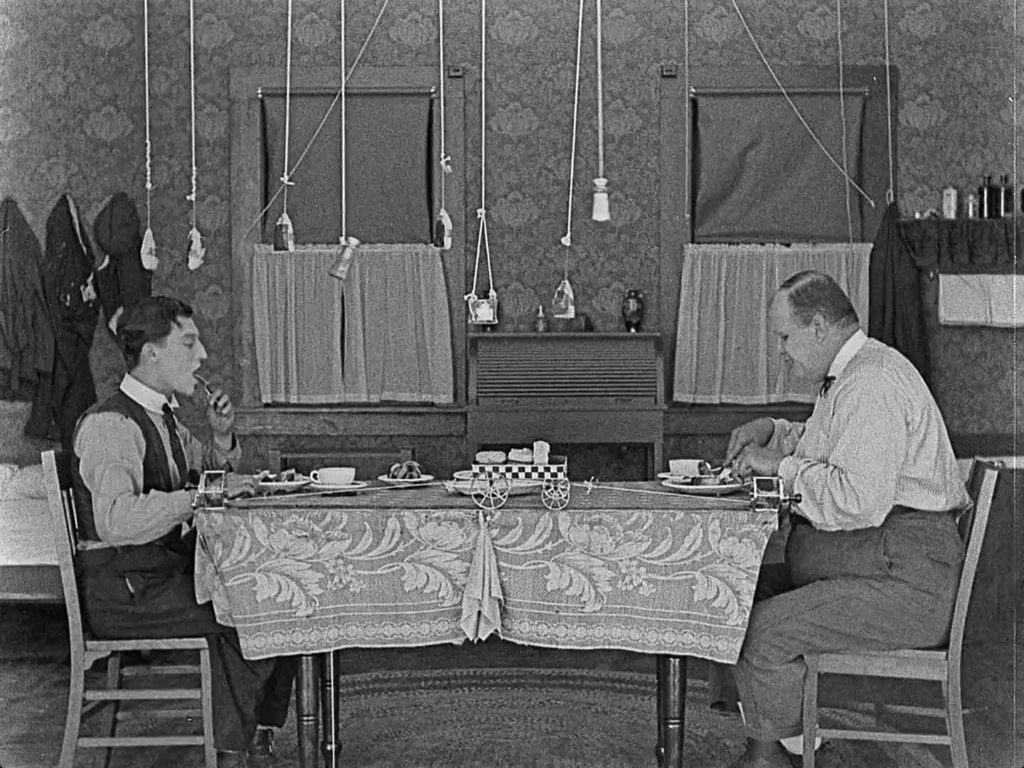The Scarecrow (1920) has gradually become one of my alternate go-to Keaton shorts for audiences. In the event I’ve already shown them One Week, or am doing a general audience program for a newbie crowd, this one really lands. It’s also one of the few Keaton shorts with a set-piece that could be synched to music.
There are a few gags in Keaton’s short comedies where he dances or where there are little moments that have a musical connection. The food-on-pulleys breakfast that’s about halfway through reel one in The Scarecrow, however, is a standout. The entire first half of the picture plays out like one of the shorts Buster made with Roscoe Arbuckle, with Joe Roberts standing in as Roscoe in his role as a friendly rival and not “the heavy” in the picture. It’s one of the rare occasions when “Big Joe” does not wear a mustache. I blogged about my theories on this here.
The hidden gem for me in this picture is this breakfast sequence. Regardless of what you play for it, it works. It’s clever, and shows off Buster’s mechanical engineering sensibilities, and gets laughs.

As I’ve played for it over the years, one thing that struck me is the fact that the sequence is covered mainly in a few long sustained takes, with the camera placement choice one that favors performance. There are a couple cutaways, taken to help with editing, and maybe Roberts just couldn’t catch the tomato on his fork. It may have been easier to take that (over and over) in a medium shot than to take the whole routine over again.
Because, the whole thing is very carefully timed and choreographed. That’s what I picked up on. Some years ago, figuring this was choreographed for the scene and that maybe even music was played on set to help with the timing, I began playing a waltz to go with the routine.
It fits.
I found I had to breathe a little with it here and there, and fluctuate the tempo just a tad, but even with the insert shot the beat is pretty consistent. Lee Erwin told me he’d noticed Keaton seemed to have been careful with this sort of thing. He’d said he found that if there was a scene with people marching, and you played something that matched it, if there was a cutaway and you kept the beat going, when he cut back you’d still be in synch more or less.
I’ve tried playing something in a light intermezzo feel in 4/4, and that also seems to work. I don’t think I’m interpolating something here. From the care and choreography (and rehearsals!) that seems to have gone into this, my take on the meal gag here is that having the music go with it is part of the gag. Having it play as a piece of dance seems to make the sequence land better, and honors Keaton’s — and Arbuckle’s? — intent.
Great Work! I’m going to have to watch The Scarecrow this evening, although it will be bereft of that incredible score.
These are some actually-not-bad Tiny House design ideas. :) To your point on tempo, I’ve read of Buster’s use of a metronome (and sometimes music) during complicated sequences, especially those requiring multiple exposures.
Yes! When I made “Ben Model’s Crazy House” in super 8mm when I was in high school, I did the same thing with a metronome for my multiple-exposures.